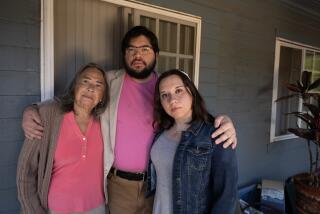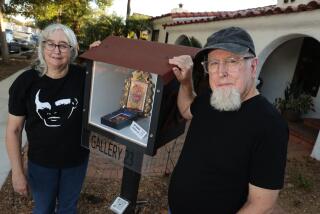What’s It Take to Raise a Village?
A decade after Santa Ana created Artists Village to perk up its struggling downtown, property values are soaring -- but the trendy district is still struggling to draw visitors and forge a lasting identity.
Many who live or work in the area say high rents are driving out the artists. And they complain that timid city officials have failed to promote the area and blocked creative ideas.
City officials lured artists to the area with the hope that investment would follow. Now, some of the artists are leaving because rents and home prices are soaring with an influx of professionals looking for relative bargains in Orange County’s overheated real estate market.
The village “has lost its raw element,” said Delilah Snell, co-founder of a nonprofit organization that has unsuccessfully sought to set up a farmers market nearby. “It’s too controlled. There’s too much money.”
Even some Santa Ana officials worry that the city -- which controls the area through building standards, event permits, sign ordinances, liquor licenses and similar means -- is being too restrictive.
“The city has a tendency of getting in its own way,” said Planning Commissioner Don Cribb, an early proponent of Artists Village. “They are risk-averse. [But] sometimes not taking risks is the greatest risk of all.”
City officials, who worked hard to rid the area of gritty bars and boarded-up buildings and have invested $11 million in the effort, say they are taking pains to ensure that the area develops on a solid foundation.
The city “must take things slow. We have to look carefully at what we are doing,” said Pat Whitaker, executive director of the city’s Community Development Agency. For example, “if one restaurant fails, we could have problems in others.”
Despite the complaints, Artists Village -- which will mark its 10th anniversary in October -- is doing well by some measures. About two dozen art galleries and at least 100 artists are working in the area. Newly built loft condominiums are selling quickly, even at more than a half-million dollars each. New businesses are opening in the district, where monthly rents have jumped from as little as 45 cents to $1.25 a square foot.
But no one would mistake it for Greenwich Village -- or even Laguna Beach. Galleries are open mostly by appointment only. Few restaurants stay open late, and all must close by midnight, according to city law.
Sparse foot traffic and rising rents have forced out some artists, art galleries and theater companies, whose presence lent the district its atmosphere.
One of those who left is Vladimir Cora, a well-known painter. And rising rent was a major reason for the Hunger Artists theater troupe moving to Fullerton in 2002 and the 10-year-old Alternative Repertory Theater closing after one year.
Also lost was Cunningham Gallery of Fine Art, owned by Norma Cunningham and her husband, painter Anthony Cunningham. The couple left in 2003 for the Scottsdale area in Arizona because they could not sell enough art, Norma Cunningham said.
The village’s monthly art night -- the first Saturday of each month, when galleries stay open late -- draws crowds, but few people come with checkbooks ready, she said. The events “made us an entertainment entity. We never sold anything.”
Among those preparing to leave is Rude Guerrilla Theater Company, which has a 40-seat theater. Artistic Director Dave Barton said the troupe, which has presented a new show in its Artists Village location every six weeks for seven years, is likely to move in 2005 because the rent is expected to jump from about $2,250 to $3,500 a month, Barton said.
“The city totally ignored us ... and we are part of the reason that the Artists Village is the Artists Village,” Barton said, who would have liked the city to subsidize the theater.
The result of these departures is that some residents are unhappy.
In the Santora Building on Broadway, the district’s centerpiece, “the display windows are [for] a vitamin store, a furniture store and a picture-frame shop and a restaurant,” said city resident Barry Jensen, who wrote to City Council members to urge them to take action, although he is neither an artist nor a village resident. “Some of it is art-related, but it’s not art. If I’m an outsider and I approach the Santora Building, I don’t see any art.”
Developer Mike Harrah, who owns the Santora Building, said he needs the mainstream businesses because he cannot afford to continue subsidizing artists and galleries.
“We have to start making some money,” said Harrah, who said he has run the building with a $10,000 monthly deficit for three years. “We’ll keep the artists in, but we need someone who can pay the rent,” said Harrah.
Some say the problem is a lack of awareness among potential visitors. And they blame the city.
Others say the city should have found the money to keep the city’s arts administrator, Jim Gilliam, on the payroll after grants paying for his job ran out. Without him, galleries have lost a crucial coordinator who prevented overlapping events and kept the parties in communication with one another.
Planning experts, however, urge critics to give the effort time. Creating an art district requires years of promotion and development, they say.
“I would caution patience,” said UC Irvine planning professor Marlon Boarnet. “A downtown project is a slow and incremental project,” he said, because it involves changing the use of existing structures instead of building new ones.
“People look at Old Town Pasadena and the Santa Monica Promenade,” said Margo Wheeler, deputy director of planning in Las Vegas, which is nurturing its own downtown arts district. But “they don’t know the decades it took to do that. It’s not an overnight thing to create a pedestrian walk with culture, shopping and housing.”
City officials say they have done the best they can with limited resources.
Whitaker said state funds that could have been used to subsidize retail and residential projects, and help developers amass land, have dried up.
“There may be some impatience,” she acknowledged. But “we want to move forward. We need the private sector to drive this now.”
Indeed, residents who want more restaurants, more music, more bars and more promotion of them have taken matters into their own hands. A restaurant association and the Artists Village Neighborhood Assn. have been formed.
Artist Brian Christenson has no trouble envisioning a bustling Artists Village. He and his wife, Robin, bought a Santa Ana loft for about $300,000 in the village nearly two years ago. While maintaining other jobs, they opened Scribble Theory Gallery last year on the bottom floor of the loft and have sold thousands of dollars in oil paintings on the first Saturday of each month. Other sales come by appointment.
“A lot of people told us we were crazy when we moved,” Christenson said, but “there is a lot of potential here.”
More to Read
Sign up for Essential California
The most important California stories and recommendations in your inbox every morning.
You may occasionally receive promotional content from the Los Angeles Times.










